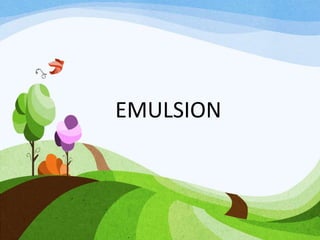This document defines and describes emulsions. It states that an emulsion is an unstable mixture of two immiscible liquids stabilized by an emulsifying agent. Emulsions are classified as simple (macro) emulsions, multiple emulsions, or microemulsions. Simple emulsions can be oil-in-water or water-in-oil, while multiple emulsions contain both types simultaneously. Microemulsions are clear, stable mixtures with particle sizes less than 120nm. The document also discusses emulsifying agents, formulation components, stability issues like flocculation and creaming, and identification tests.


















































